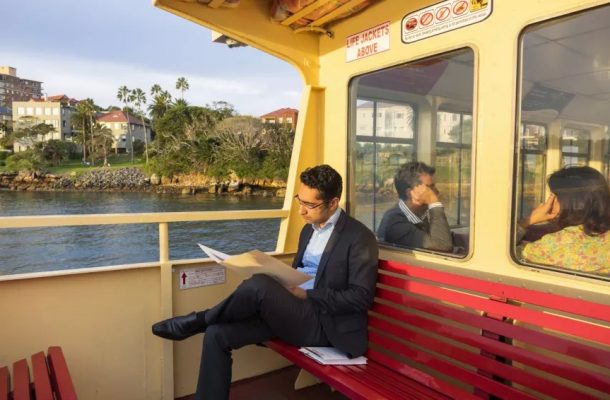How commuting is transforming our cities

“Overslept. So tired. If late. Get fired. Why bother? Why the pain? Just go home. Do it again.”
These sardonic lines adorn eight low ceiling beams in a dingy underground passageway between the Port Authority and Times Square subway stations in the heart of New York City. “The Commuter’s Lament” is an art installation by Norman B. Colp, commissioned by the Metropolitan Transportation Authority in 1991.
Far from providing diversion, these lines zero in on the life situation that many commuters striding beneath them find themselves in day after day. Simultaneously mocking and commiserating, the lines evoke a pessimistic sense of the overtired and overworked life of the commuter.
Nobody, it would seem, likes to commute.
As one study by psychologist Douglas Kahneman and colleagues found, of all daily activities, commuting was ranked by participants as the least satisfying. The study suggests that commuting is an activity that many would happily give up in exchange for doing something more pleasurable or rewarding.
But commuting is one of the most significant travel practices of our time. This twice-daily ebb and flow of people is one of the major rhythms of contemporary urban life.
A survey in London reported that on average British workers will spend one year and thirty-five days commuting 191,760 miles, or 308,607 kilometres, in their lifetimes.
Although it might feel like commuting has always been part of urban life, it is a relatively recent phenomenon. Before the twentieth century, people in many cities tended to live much closer to their places of work. Rewind to the early nineteenth century: People only travelled about fifty meters a day on average.
Then, as industry and commerce expanded and became increasingly centralized in cities, demand for workers’ accommodation grew and cities developed outwards. The construction of vast suburban railway networks in many cities in the early twentieth century helped to transport large volumes of people efficiently and relatively cheaply into the city from the new outer suburbs, effectively bringing once-distanced locations closer together.
The origin of the word commute itself heralds from the late nineteenth-century United States’ commutation ticket, a reduced price railway season ticket by which the price of multiple daily tickets was “commuted” into a single payment. It was not until the 1960s and 1970s that the car became such a dominant way to commute in many cities.
From Mexico City to Milan, and from Shenzhen to Sydney, transport infrastructures in many large cities around the world are at a breaking point.
In Mumbai, for instance, 7.5 million riders travel each day on some of the most overloaded trains in the world. Every day, there are twenty to twenty-five serious accidents and between ten and twelve people are killed. Some stations even employ their own undertakers.
For environmentalists, this mass daily mobility is a problem viewed in terms of the carbon emissions contributing to human-induced climate change, as well as the detrimental localized effects of air pollution on the health of city dwellers.
For public health professionals, commuting means that many people are leading more sedentary lives than before, hemmed into cars or wedged into seats on public transport and thus increasing problems such as back pain and cardiovascular disease.
But journeys between work and home are a strange, liminal part of our lives. They are curiously suspended between the other activities we undertake at home and work – activities that, for better or worse, give our lives meaning and shape who we are.
However, these journeys are often so deeply routinised that we rarely stop to think about them. The blindingly familiar world of traffic and travel has become so deeply grooved into the everyday life of cities that it often goes unremarked upon.
How is commuting affecting the social fabric of urban life, striking to the core of who we are? Would our lives really be better without commuting?
All the events that we experience, all the environments that we move through, impress on us and leave their mark. They might increase some capacities while depleting others. Even if we are not conscious of how an event has affected us at the time, we might come to realise, sometimes much later, how forceful that event was.
Think of how being in a specific place can catch us off guard by sparking a memory that might be felt with overwhelming intensity. Our capacities to be affected by things and our capacities for action change through the experiences that we have.
However, in parallel, our own presence changes the world as well.
Think about how we might have left traces on the people that we travel with and on the environments that we travel through. What we experience becomes part of who we are — and who we are comes to be part of the environments that we move through.
This has some profound implications for reimagining the significance of our everyday commutes. For many writers, it is the exceptional experiences of travel associated with touring and vacations that are imagined as being transformative.
Recall here the life-changing impetus for the Odyssean classical-era Grand Tour around Europe undertaken by the elite youth of the day. Or, when planning a holiday, think of how we might hope that it will transform our being in some way.
The everyday journeys that we make to and from work can be transformative in ways that are different, but no less profound.
This is an edited extract from Dr David Bissell’s new book Transit Life, which is out now, from MIT Press, and available from online retailers and all good bookstores. This article was published by Pursuit.
David is Associate Professor and Australian Research Council Future Fellow in the School of Geography at Melbourne University. He combines qualitative research on embodied practices with social theory to explore the social, political and ethical consequences of mobile lives













